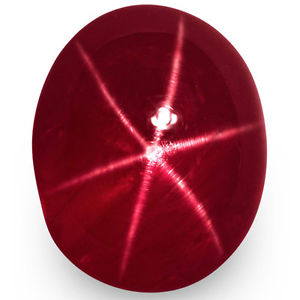Star Ruby
- Home /
- Birthstones by Month /
- Star Ruby
It is why diamonds that have formed naturally over eons, and under the formidable conditions raging on beneath our feet, are prized over and above their lab-grown counterparts, even in spite of the fact that the real thing is likely to feature inclusions that the synthetic diamond does not. These slight imperfections are evidence of the unique circumstances that first created it.
Furthemore, rubies have a rich history among the wealthy and aristocracy during medieval times. It was believed to possess special abilities and represented power, while in biblical times it symbolized wisdom and beauty. The precious stone, thus, is truly one of a kind.
The Star Ruby offers another perfect example of the inherent value of these inclusions and imperfections. While, at first glance, it would appear to bear all the usual traits of a precious stone, it takes its name from the precise and incredibly unlikely formation of its inclusions.
While, in many gemstones, any inclusions will simply disrupt the symmetry of the stone’s internal structure, the star ruby’s inclusions occur in such a way that a star shape is created.
It goes without saying that these rubies are incredibly rare – so rare, in fact, that star rubies represent a highly coveted and much sought-after phenomenon among collectors, dealers, and enthusiasts alike.
The Star Ruby
Inclusions are far more common than perfection and, within the ruby, they can occur in many different ways. Some will appear as the smallest of imperfections – for instance, silk inclusions, named for their fine, diaphanous appearance. Others, such as clustered, fingerprint-like inclusions, can impact the light performance of the gemstone. The most disruptive faults, such as cavities and cracks, can weaken the ruby’s structure.
The star ruby, however, is created by a very specific arrangement of slender inclusions known as needles. In this instance, these needles comprise incredibly fine crystals of titanium dioxide, which is highly reflective.
Under the right circumstances, these needles can occur in such a way as to reflect light in the shape of a six-pointed star across the surface of the ruby. This effect is referred to as ‘asterism’, and can be found on many different kinds of gemstone.
As we mentioned above, this is an incredibly unlikely occurrence – not to mention a prime example of the unparalleled beauty of nature’s design.
How Common is a Natural Star Ruby?
Approximately 2% of the rubies we draw from the earth will feature a star, but fewer still will be of a high enough quality to prove valuable to collectors and dealers.
While we are all familiar with the archetypal ruby color – also known as pigeon blood – the rough corundum that is first brought from the mines varies drastically in tone and hue. There are many stones for which the color dramatically lowers its selling price and, unfortunately, many star rubies will suffer from this. Similarly, the star can be – and often is – too subtle to prove desirable on the market.
Only half of the corundum that features a star will be considered a high enough quality to be sold as star rubies to collectors and jewelers, which translates to approximately 1 in every 100 mined rubies featuring this striking, celestial feature.
The Star Ruby Meaning
As a gemstone, the ruby holds a great significance around the world. It is the second hardest mineral on earth, and only surpassed by diamond.
The ruby is also the birthstone for those born in July – and, unlike many other months, this has remained the same since ancient times. Its beauty has captivated civilizations across time and space – a fact which has enabled it to take on many meanings over the centuries. Its color lends itself to feelings of passion and romance, as well as vitality and resilience.
The star ruby stone is considered one of the rarest iterations of this gemstone, with some of the world’s most sought-after collections selling for millions of dollars.
Coloration
The coloration and transparency of ruby varies drastically, and each gemstone’s exact weight, size, and appearance will be entirely unique. While we may picture that archetypal, pigeon blood red color when we hear the word ‘ruby’, many gemstones will fall elsewhere on a wide color spectrum, and may feature orange or purple undertones that typically decrease its value on the market.
Typically, rubies that are too light are instead named pink sapphires and sold at a lower cost – although the case is entirely different for star rubies. The presence of titanium dioxide effectively ‘disrupts’ the gemstone’s color, softening the red to a more opaque, milky shade.
Shape
As mentioned, ruby is mined from the earth as corundum – a rough, crystalline mineral that must be cut into a suitable shape. Often, translucent rubies with fewer inclusions are cut with facets – much like a diamond.
For the star ruby, however, cutting the gemstone into a cabochon – or a smooth-sided, high-domed oval or circle, without faceting – is the best way to display the asterism. These cabochons can be crafted into jewelry and other luxury items.
The Star Ruby
The very fact that star rubies remain one of the most sought-after gemstones stands as proof of the unrivalled beauty of nature. Its appearance exists entirely by chance, and as a result of natural imperfections that have been eradicated within lab-grown imitations.
Our fascination with these rubies has gone unchanged and unrivalled across generations and, whether we derive significance from its expression of the rare paradox of ‘perfect impurities’ – or from the celestial charm of its appearance – it is clear that nothing can challenge or unseat the star ruby from its high status across the globe.

 Star Ruby
Star Ruby